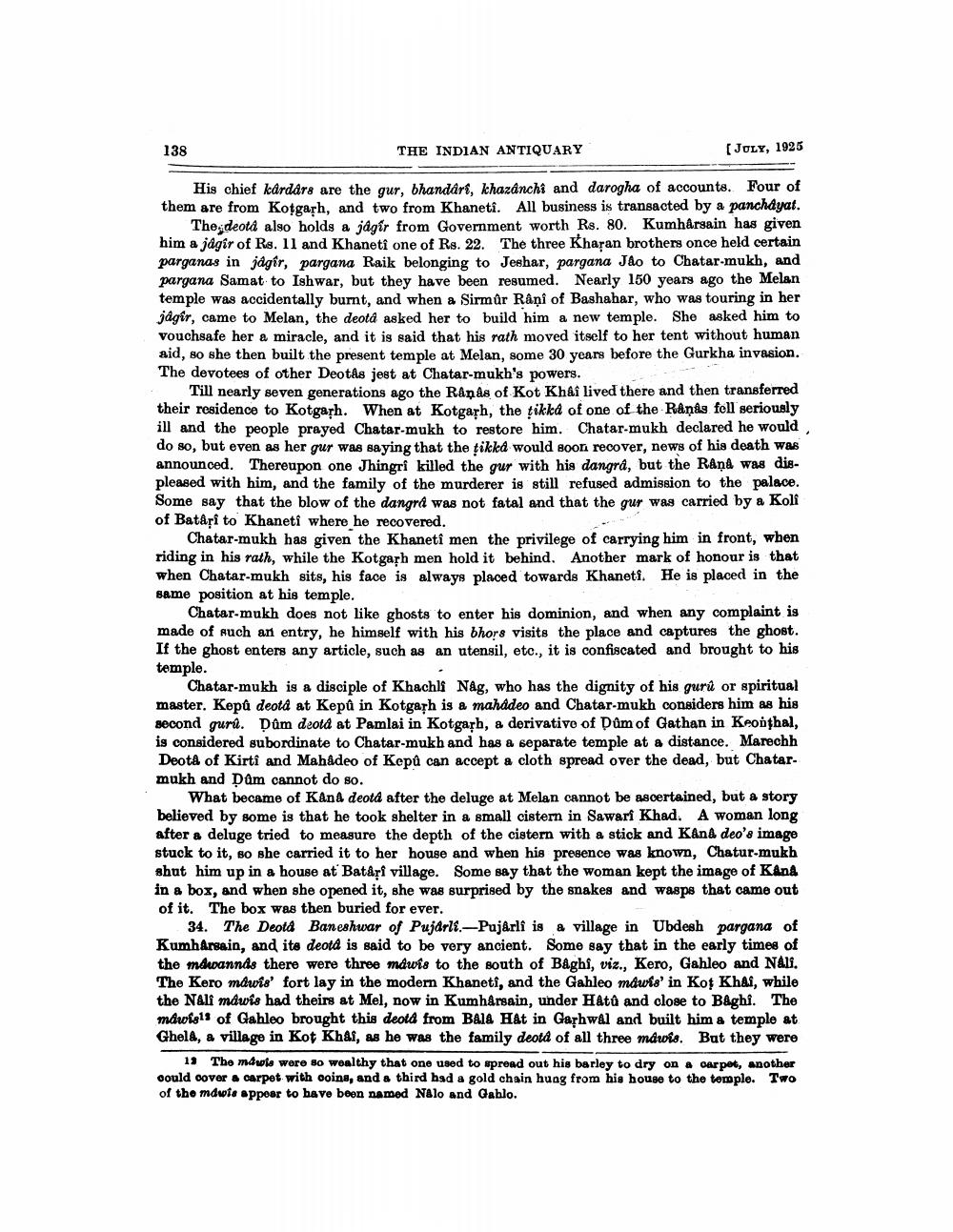________________
138
THE INDIAN ANTIQUARY
[JULY, 1925
His chief kardars are the gur, bhandart, khazanchi and darogha of accounts. Four of them are from Kotgarh, and two from Khaneti. All business is transacted by a panchayat.
The deotà also holds a jagir from Government worth Rs. 80. Kumhargain has given him a jdgir of Rs. 11 and Khaneti one of Rs. 22. The three Kharan brothers once held certain parganas in jagir, pargana Raik belonging to Jeshar, pargana Jao to Chatar-mukh, and pargana Samat to Ishwar, but they have been resumed. Nearly 150 years ago the Melan temple was accidentally burnt, and when a Sirmûr Râni of Bashahar, who was touring in her jagîr, came to Melan, the deotá asked her to build him a new temple. She asked him to vouchsafe her a miracle, and it is said that his rath moved itself to her tent without human aid, so she then built the present temple at Melan, some 30 years before the Gurkha invasion. The devotees of other DeotAs jest at Chatar-mukh's powers.
Till nearly seven generations ago the Rånås of Kot Khas lived there and then transferred their residence to Kotgarh. When at Kotgarh, the tikkd of one of the Raņas fell seriously ill and the people prayed Chatar-mukh to restore him. Chatar-mukh declared he would do so, but even as her gur was saying that the tikkd would soon recover, news of his death was announced. Thereupon one Jhingri killed the gur with his dangra, but the Rånd was displeased with him, and the family of the murderer is still refused admission to the palace. Some say that the blow of the dangra was not fatal and that the gur was carried by a Koli of Batari to Khaneti where he recovered.
Chatar-mukh has given the Khanetî men the privilege of carrying him in front, when riding in his rath, while the Kotgarh men hold it behind. Another mark of honour is that when Chatar-mukh sits, his face is always placed towards Khaneti. He is placed in the same position at his temple.
Chatar-mukh does not like ghosts to enter his dominion, and when any complaint is made of such an entry, he himself with his bhors visits the place and captures the ghost. If the ghost enters any article, such as an utensil, etc., it is confiscated and brought to his temple.
Chatar-mukh is a disciple of Khachli Nag, who has the dignity of his gurú or spiritual master. Kepû deotd at Kepů in Kotgah is a mahadeo and Chatar-mukh considers him as his second guru. Dům deota at Pamlai in Kotgarh, a derivative of Dam of Gathan in Keonthal, is considered subordinate to Chatar-mukh and has a separate temple at a distance. Marechh Deota of Kirti and Mahadeo of Kepû can accept a cloth spread over the dead, but Chatarmukh and Dam cannot do so.
What became of Kana deotá after the deluge at Melan cannot be ascertained, but a story believed by some is that he took shelter in a small cistern in Sawari Khad. A woman long after a deluge tried to measure the depth of the cistern with a stick and Kan& deo's image stuck to it, so she carried it to her house and when his presence was known, Chatur-mukh shut him up in a house at Batari village. Some say that the woman kept the image of Kana in a box, and when she opened it, she was surprised by the snakes and wasps that came out of it. The box was then buried for ever.
34. The Deota Baneshwar of Pujarli.-Pujârli is & village in Ubdesh pargana of Kumharsain, and its deotd is said to be very ancient. Some say that in the early times of the mduannds there were three mawis to the south of Baghi, viz., Kero, Gahleo and Nali. The Kero mawis' fort lay in the modern Khaneti, and the Gahleo mawis' in Kot Khai, while the Nali mawis had theirs at Mel, now in Kumhårsain, under H&tâ and close to B&ghi. The mdwig1s of Gahleo brought this deotd from BAIA Hat in Garhwal and built him a temple at Ghela, a village in Kot Khal, as he was the family deotd of all three mdwis. But they were
13 The mawls were so wealthy that one used to spread out his barley to dry on a carpet, another could cover & carpet with ooins, and a third had a gold chain hung from his house to the temple. Two of the mdwis appear to bave been named Nalo and Gablo.




